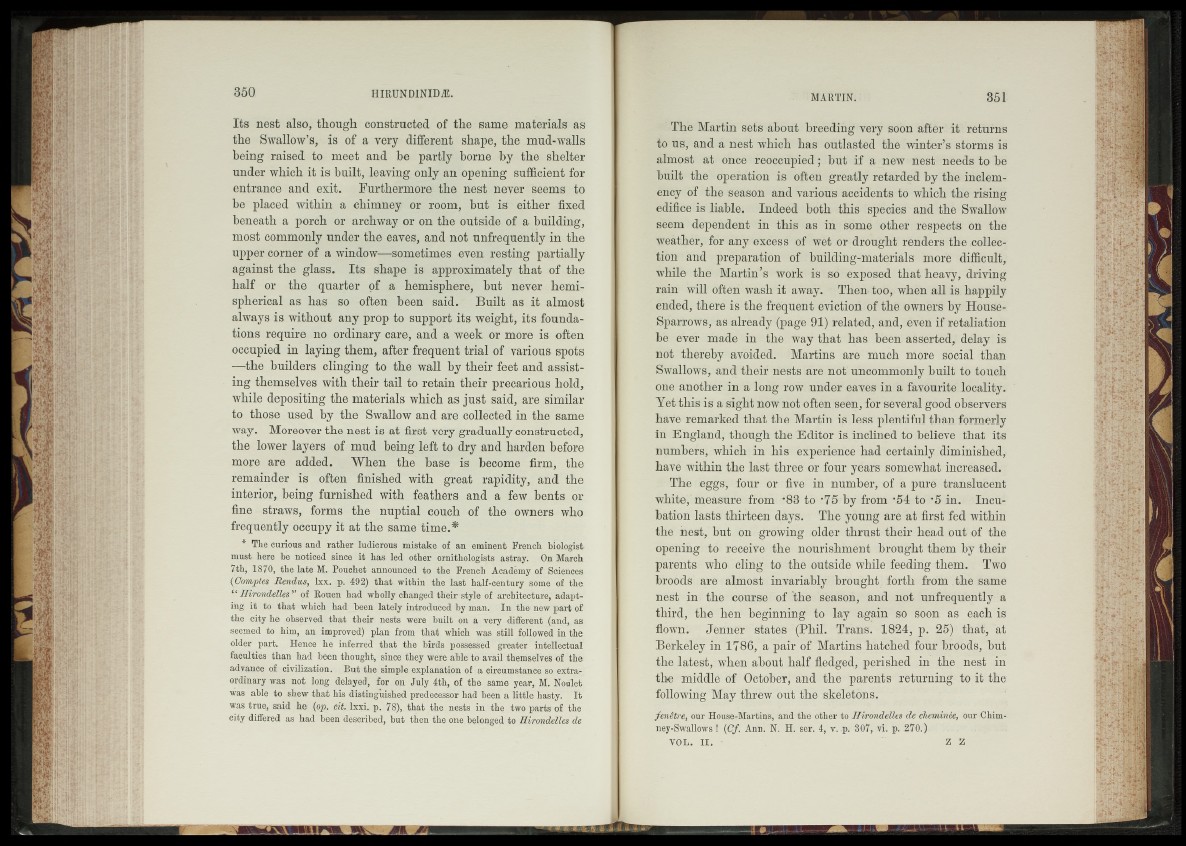
Its nest also, though constructed of the same materials as
the Swallow’s, is of a very different shape, the mud-walls
being raised to meet and be partly borne by the shelter
under which it is built, leaving only an opening sufficient for
entrance and exit. Furthermore the nest never seems to
be placed within a chimney or room, but is either fixed
beneath a porch or archway or on the outside of a building,
most commonly under the eaves, and not unfrequently in the
upper corner of a window—sometimes even resting partially
against the glass. Its shape is approximately that of the
half or the quarter of a hemisphere, but never hemispherical
as has so often been said. Built as it almost
always is without any prop to support its weight, its foundations
require no ordinary care, and a week or more is often
occupied in laying them, after frequent trial of various spots
—the builders clinging to the wall by their feet and assisting
themselves with their tail to retain their precarious hold,
while depositing the materials which as just said, are similar
to those used by the Swallow and are collected in the same
way. Moreover the nest is at first very gradually constructed,
the lower layers of mud being left to dry and harden before
more are added. When the base is become firm, the
remainder is often finished with great rapidity, and the
interior, being furnished with feathers and a few bents or
fine straws, forms the nuptial couch of the owners who
frequently occupy it at the same time.*
* The curious and rather ludicrous mistake of an eminent French biologist
must here be noticed since it has led other ornithologists astray. On March
7th, 1870, the late M. Pouchet announced to the French Academy of Sciences
(Comptes Rendus, lxx. p. 492) that within the last half-century some of the
“ Hirondelles ” of Rouen had wholly changed their style of architecture, adapting
it to that which had been lately introduced by man. In the new part of
the city he observed that their nests were built on a very different (and, as
seemed to him, an improved) plan from that which was still followed in the
older part. Hence he inferred that the birds possessed greater intellectual
faculties than had been thought, since they were able to avail themselves of the
advance of civilization. But the simple explanation of a circumstance so extraordinary
was not long delayed, for on July 4th, of the same year, M. Noulet
was able to shew that his distinguished predecessor had been a little hasty. It
was true, said he (op. cit. lxxi. p. 78), that the nests in the two parts of the
city differed as had been described, but then the one belonged to Hirondelles de
The Martin sets about breeding very soon after it returns
to us, and a nest which has outlasted the winter’s storms is
almost at once reoccupied ; but if a new nest needs to be
built the operation is often greatly retarded by the inclemency
of the season and various accidents to which the rising
edifice is liable. Indeed both this species and the Swallow
seem dependent in this as in some other respects on the
weather, for any excess of wet or drought renders the collection
and preparation of building-materials more difficult,
while the Martin’s work is so exposed that heavy, driving
rain will often wash it away. Then too, when all is happily
ended, there is the frequent eviction of the owners by House-
Sparrows, as already (page 91) related, and, even if retaliation
be ever made in the way that has been asserted, delay is
not thereby avoided. Martins are much more social than
Swallows, and their nests are not uncommonly built to touch
one another in a long row under eaves in a favourite locality.
Yet this is a sight now not often seen, for several good observers
have remarked that the Martin is less plentiful than formerly
in England, though the Editor is inclined to believe that its
numbers, which in his experience had certainly diminished,
have within the last three or four years somewhat increased.
The eggs, four or five in number, of a pure translucent
white, measure from -83 to '75 by from v54 to '5 in. Incubation
lasts thirteen days. The young are at first fed within
the nest, but on growing older thrust their head out of the
opening to receive the nourishment brought them by their
parents who cling to the outside while feeding them. Two
broods are almost invariably brought forth from the same
nest in the course of the season, and not unfrequently a
third, the hen beginning to lay again so soon as each is
flown. Jenner states (Phil. Trans. 1824, p. 25) that, at
Berkeley in 1786, a pair of Martins hatched four broods, but
the latest, when about half fledged, perished in the nest in
the middle of October, and the parents returning to it the
following May threw out the skeletons.
fenêtre, our House-Martins, and the other to Hirondelles de cheminée, our Chimney
Swallows ! (Of. Ann. N. H. ser. 4, v. p. 307, vi. p. 270.)